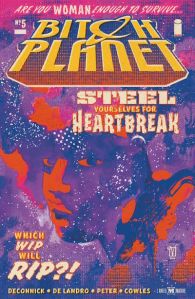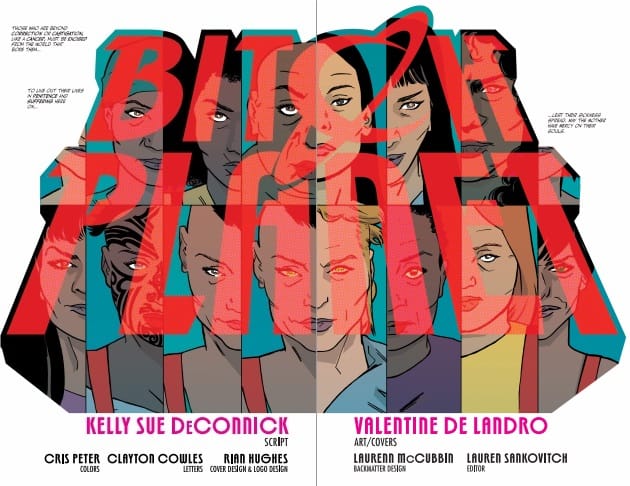
Pages 5-6
The 2-page title spread and credits. This spread juxtaposes the lofty diction of the Fathers’ decree of their punishment with the faces of the newly formed ACO Megaton Team. And as they are in the action of the story, the two are at odds.
The Fathers liken these women, “beyond correction or castigation,” to an illness–cancer–which must be cut out of the body before it is destroyed. Feminism here, the revolt against the expectations of women in society, is cast as a serious threat to society, not a force that might strengthen it by elevating the oppressed to fully participate and contribute. To keep their hold over society, the Fathers’ law is pitched with a mythic or biblical diction. Though these women are being cast out, the Mother is called upon to give their souls mercy. The Mother is the only salvation left to them.
Asserting against the Fathers’ word is the collage of faces. The mix of facial features, skin tones, and expressions gives an image to the term “intersectional.” What is striking is the diversity of the team, and yet, each has an expression of contained aggression–some serious, others with a slight smirk or raised eyebrow to suggest a tinge of enjoyment. They come from different places, carrying with them the punishment of various crimes, but now they are a team.
Pages 7-8
Another 2-page spread, giving a width to the narrative that makes the scene feel more expansive, less contained in the small space of the page. It gives room for de Landro to depict the full team of women. It’s also hell to read digitally. Kamau is coaching the team on the plays prior to the start of their first scrimmage, a game against the ACO guards. A few new inmates/team members are introduced.
The blue/pink color scheme continues, though here the pink has been dialed up to red, suggesting the threat level these women pose. But they remain backed and surrounded by blue, that masculinity forcing dichotomy in femininity. But these women shake those expectations off and, thus, are threats.
Cells 1-6 are a six-panel row mimicking the point-of-view of a team member, perhaps April or May who are being addressed, tracking Kamau’s diagram and instructions for a play. Act as an offensive decoy, pick off two of the guards, leaving only one for Penny to allow Meiko through. This row is the shortest, and it’s dwarfed by the massive Cell 7 which takes the entire width of the 2-pages and a third of the height. It depicts the entire team, looking at the strategy Kamau has just presented. Could it be that the upper row depicts many eyes’ point of view of the board? That would explain the segmentation of it more than simple narrative sequencing.
The women are depicted in varying stances and poses, some spreading out in masculine fashion, taking up space, being seen and reckoned with. The angles of lines and eyes in the frame bring the attention to Kamau, despite the many women and two guards vying for attention in the panel. Kamau asks if there are any questions. The twins answer “no” simultaneously. But a woman in the back of the panel says she has one. It’s the million dollar question, posed in Cell 8 in a medium close-up: “Are we really gonna go back home?”

Cell 9 brings Kamau’s answer in close-up: “…Probably not.” She hesitates before the answer, perhaps weighing the possible loss of a player with the realization that there is no reward for playing, or perhaps she understands that even if they do get to go home, they still don’t go home. Not in an emotional sense anyway. They are outcasts, and that changes a person. Home doesn’t have the promise of safety or acceptance anymore. We saw what society does to homes like that in the flashback of Penny’s time living with her grandmother in issue #3.
Cell 10 sits directly below 9, giving a bit of a directional zig before zagging back to the right. Another player calls BS on the proceedings. No news there. These women are no strangers to the broken promises of society. But off-panel another player grabs Kamau’s attention. She calls on her: “Yes, Nut?”
 Cell 11 gives us our introduction to Nut Suhair, another medium close-up but from a low camera angle, making her look massive and intimidating. Her dossier info emphasizes the same with the image of her punching someone, open-mouthed, enraged and the somewhat explanatory text: “233 lbs. Patrilineal dishonor; murder.” She seems like a halfway point between Kamau and Penny with an Indian background, suggested by her name and skin tone. She asks the other million dollar question: “We can hit the guards? Without going to the box? And they don’t have their weapons?” Ultimately, they need to know what the rules are. Is it going to be a fair fight, or will the guards use their institutional power to physically assault or punish them? Also, I can’t help think of Cool Hand Luke with the mention of the box. Luke was another individual standing up against an oppressive system and did many nights and days in “the box” for it.
Cell 11 gives us our introduction to Nut Suhair, another medium close-up but from a low camera angle, making her look massive and intimidating. Her dossier info emphasizes the same with the image of her punching someone, open-mouthed, enraged and the somewhat explanatory text: “233 lbs. Patrilineal dishonor; murder.” She seems like a halfway point between Kamau and Penny with an Indian background, suggested by her name and skin tone. She asks the other million dollar question: “We can hit the guards? Without going to the box? And they don’t have their weapons?” Ultimately, they need to know what the rules are. Is it going to be a fair fight, or will the guards use their institutional power to physically assault or punish them? Also, I can’t help think of Cool Hand Luke with the mention of the box. Luke was another individual standing up against an oppressive system and did many nights and days in “the box” for it.
Kamau reassures her in Cell 12 that they can fight the guards. No box. No weapons. However, to the right is a guard. He’s looking down, either out of disinterest or because he knows Kamau is wrong and doesn’t want to be looking at her as she leads her players astray. Classic cinematographic vocabulary uses left and right side to indicate who is in control–the right side–and who is out of control–the left. That applies here as Kamau, on the left, is being told lies about the on-field rules and being controlled by others while the in-control guard stands off to the right foreground.
Cell 13-14 bring us a final question from Penny, whose face shows her excitement to tackle their captors with permission. “Hey, Boss, I got a question…When can we start?” Her close-up in 13 switches to the team climbing the steps the scrimmage field in 14. The women walking into the light at the top of the stairs initially seems like a positive metaphor–walking towards glory or salvation; however, the image also presents the possibility of walking into a light that blinds, they do not know what they’re up against, or the light of death’s salvation, both of which foreshadow Meiko’s death.





